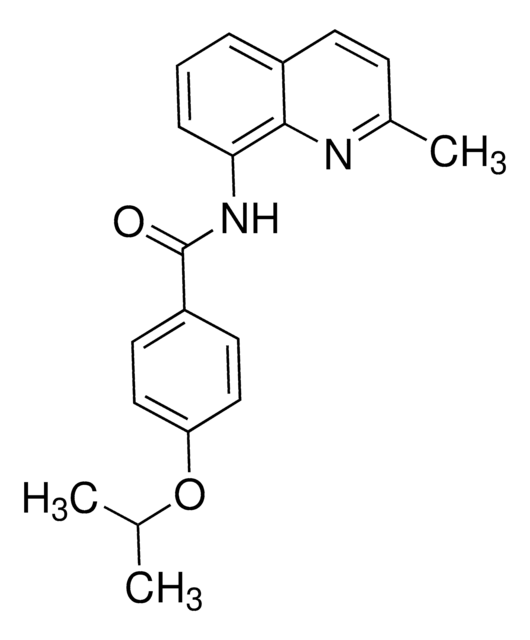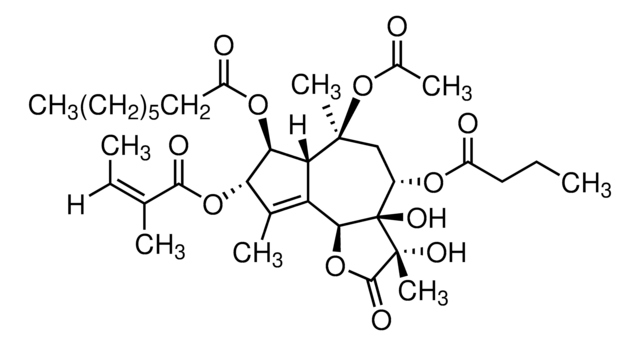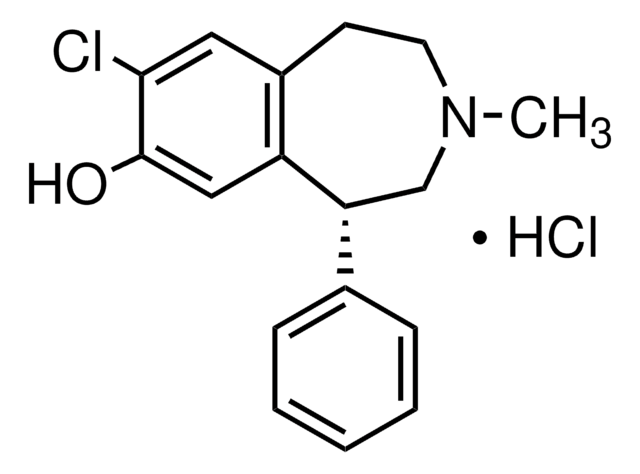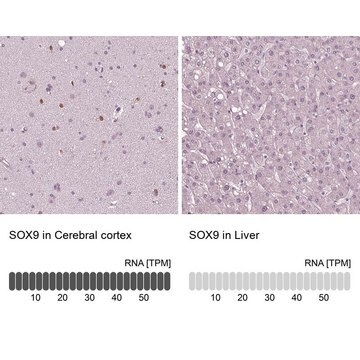おすすめの製品
品質水準
アッセイ
≥98% (HPLC)
フォーム
powder
色
white to beige
溶解性
DMSO: 5 mg/mL, clear
保管温度
2-8°C
SMILES記法
ClC1=C(C(NN)=O)SC2=CC=CC(Cl)=C21
InChI
1S/C9H6Cl2N2OS/c10-4-2-1-3-5-6(4)7(11)8(15-5)9(14)13-12/h1-3H,12H2,(H,13,14)
InChI Key
HSSHUDKWJRJKPV-UHFFFAOYSA-N
詳細
Inhibition of 8-oxoguanine DNA glycosylase-1 (OGG1) can be used in monotherapy or in combination therapy to treat some types of cancer.
生物化学的/生理学的作用
OGG1 Inhibitor O8 is a potent inhibitor of 8-Oxoguanine DNA Glycosylase-1 (OGG1), part of the DNA base excision repair (BER) pathway that is becoming a drug target for cancer therapy.
OGG1 Inhibitor O8 is a potent inhibitor of 8-Oxoguanine DNA Glycosylase-1 (OGG1), part of the DNA base excision repair (BER) pathway that is becoming a drug target for cancer therapy. OGG1 Inhibitor O8 has an IC50 value of 220 nM and >100-fold selectivity for OGG1 relative to several other DNA repair glycosylases. O8 acts through the inhibition of Schiff base formation during OGG1 catalysis. It does not prevent DNA binding of OGG1 to a 7,8-dihydro-8-oxoguanine (8-oxo-Gua)-containing substrate.
シグナルワード
Warning
危険有害性情報
危険有害性の分類
Eye Irrit. 2 - Skin Irrit. 2 - STOT SE 3
ターゲットの組織
Respiratory system
保管分類コード
11 - Combustible Solids
WGK
WGK 3
引火点(°F)
Not applicable
引火点(℃)
Not applicable
適用法令
試験研究用途を考慮した関連法令を主に挙げております。化学物質以外については、一部の情報のみ提供しています。 製品を安全かつ合法的に使用することは、使用者の義務です。最新情報により修正される場合があります。WEBの反映には時間を要することがあるため、適宜SDSをご参照ください。
Jan Code
SML1697-BULK:
SML1697-25MG:
SML1697-VAR:
SML1697-5MG:
最新バージョンのいずれかを選択してください:
Nathan Donley et al.
ACS chemical biology, 10(10), 2334-2343 (2015-07-29)
The DNA base excision repair (BER) pathway, which utilizes DNA glycosylases to initiate repair of specific DNA lesions, is the major pathway for the repair of DNA damage induced by oxidation, alkylation, and deamination. Early results from clinical trials suggest
Mingxin Chang et al.
Frontiers in pharmacology, 11, 610205-610205 (2021-02-02)
Background: Oncogenic transformation is associated with elevated oxidative stress that promotes tumor progression but also renders cancer cells vulnerable to further oxidative insult. Agents that stimulate ROS generation or suppress antioxidant systems can drive oxidative pressure to toxic levels selectively
Xu Zheng et al.
Journal of innate immunity, 1-22 (2022-05-06)
The primary cause of morbidity and mortality from infection with respiratory syncytial virus (RSV) is the excessive innate immune response(s) (IIR) in which reactive oxygen species (ROS) play key role(s). However, the mechanisms for these processes are not fully understood.
Hongge Wang et al.
Oncogene, 39(14), 2905-2920 (2020-02-08)
PARP1 and PARP2 play critical roles in regulating DNA repair and PARP inhibitors have been approved for the treatment of BRCA1/2-mutated ovarian and breast cancers. It has long been known that PARP inhibition sensitizes cancer cells to DNA-damaging cytotoxic agents
Wenjing Hao et al.
FASEB journal : official publication of the Federation of American Societies for Experimental Biology, 34(6), 7427-7441 (2020-05-08)
8-Oxoguanine DNA glycosylase1 (OGG1)-initiated base excision repair (BER) is the primary pathway to remove the pre-mutagenic 8-oxo-7,8-dihydroguanine (8-oxoG) from DNA. Recent studies documented 8-oxoG serves as an epigenetic-like mark and OGG1 modulates gene expression in oxidatively stressed cells. For this
ライフサイエンス、有機合成、材料科学、クロマトグラフィー、分析など、あらゆる分野の研究に経験のあるメンバーがおります。.
製品に関するお問い合わせはこちら(テクニカルサービス)









